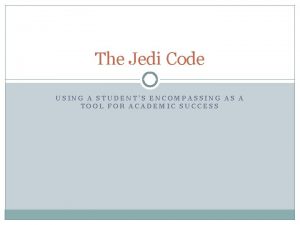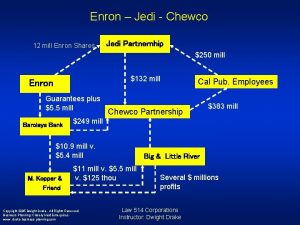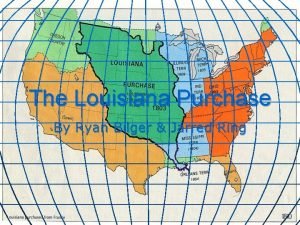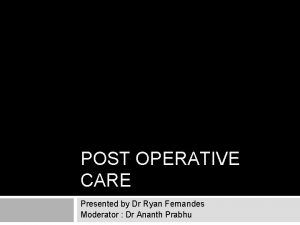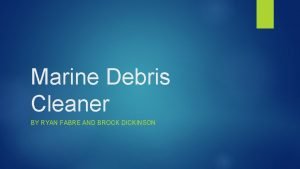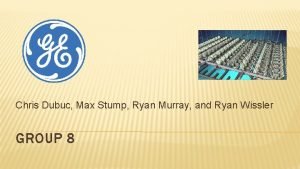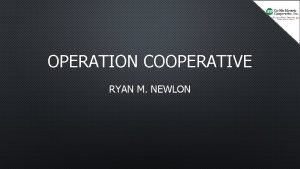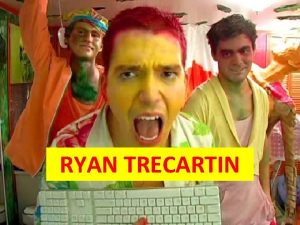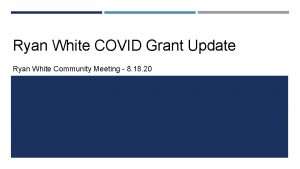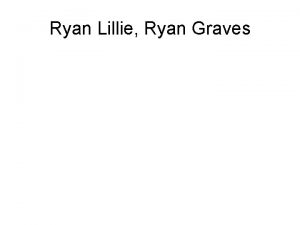JEDI and C Part 1 Ryan Honeyager JEDI


































- Slides: 34

JEDI and C++ - Part 1 Ryan Honeyager JEDI core team honeyage@ucar. edu November 18, 2020

Why Use C++? 1. We want JEDI to provide an abstract interface layer that separates the state, model, covariances, observation operators, et cetera from their specific implementations. 2. We want to take advantage of many new libraries and capabilities that are available in other languages. 3. We want to write fast code that can be implemented in an operational context. 2

Survey Results 3

C++ Resources Tutorials (easier): • • http: //www. cplus. com/doc/tutorial/ https: //www. geeksforgeeks. org/ How to write good, modern C++ (moderate): • https: //isocpp. github. io/Cpp. Core. Guidelines • http: //www. stroustrup. com/resource-model. pdf C++ reference (technical): • https: //en. cppreference. com/ Libraries: • https: //www. boost. org/ • http: //eigen. tuxfamily. org/ 4

Hello, World! 5

A Really Terse Development of Programming • In the beginning, there were calculators. They had a few logic gates and maybe a register or two of memory. • 1948 – First assembler. Used one-letter mnemonics in place of binary instructions. • 1954 – First FORTRAN. 95% reduction in code length vs assembly languages. – Fortran 66 supported program units (SUBROUTINE, FUNCTION), several data types, library functions, flow control, comments, basic I/O, go-tos, and variable names up to 6 characters in length. 6

A Really Terse Development of Programming • • 1972 – First release of C, based on B and BCPL. 1979 – K&R C “standard”, and 1989/1990 – ANSI C standard Convergent development with Fortran – many similar features. Differences from Fortran: – – – C extensively uses memory pointers. C can pass data by value, reference or by pointer. C frequently relies on a simple macro pre-processing language. Different array indices. C-Fortran data structure compatibility is still being standardized. 7

Anatomy of a C function Return type (if there is one). Otherwise, use type void. Body is enclosed in curly braces. The function name is followed by parentheses which enclose any input values required by the function when it executes. Each value needs a type and a name. int custom_function(int num_values, int* values) { int retval = 1; A pointer to a memory region size_t i; containing zero or more integers. if (!num_values) return 0; for (i=0; i<num_values; ++i) { retval *= values[i]; } return retval; } 8

C Limitations: Lack of Scope • All functions have the same scope, so no two functions can have the same name. Causes problems with libraries. • Many simple names are already taken: open, close, read, write, max, min, free, time, clock, abort. 9

C++ Namespaces Think of these as sets of identifiers (i. e. names) united under a scope (a logical group). namespace jedi_base { void do. Something(); int do. Something. Else(); namespace dates { int get. Current. Month(); int get. Current. Year(); } } namespace ioda { void do. Something(); } Points: • If an identifier is not declared in a namespace, then it is part of the global namespace. • Namespaces may be nested. • jedi_base: : do. Something() and ioda: : do. Something() are distinct functions. • What if you do not want to always type the namespace’s name? The using directive allows all names in a namespace to be used without the namespace name as an explicit qualifier. Ex: • using namespace jedi_base; do. Something. Else(); int todays. Month = dates: : get. Current. Month(); 10

C Limitations: Lack of Overloading • You need to write separate functions to do similar tasks with different data types. – fabs(double) vs fabsf(float) vs fabsl(long double) vs labs(long int) vs llabs(long int). – Macro-magic can help to get around this, but then the result is hard to debug. • In C++, multiple functions can have the same name, so long as they have different function parameters. – int max(int a, int b) and float max(float a, float b) do not conflict! 11

A Few C Limitations 12

A Few C Limitations: No Objects • There are no true “objects”, and the language is best-suited for plain-old data types. Have to allocate, initialize and deallocate structures manually, which is error-prone. • Also, you have to manually check the result of every function call for errors, and most people forget to do this. 13

A Few C Limitations • There are no true “objects” and the language is best-suited for plain-old data types. Have to allocate, initialize and deallocate structures manually, which is error-prone. • Also, you have to manually check the result of every function call for errors, and most people forget to do this. 14

A Few C Limitations: Library Support • The standard C library provides facilities for interacting with the underlying OS (via FILEs), some math, and some string manipulation functions. • It entirely lacks support for data storage containers. 15

Objects and Classes Image credit: http: //www. trytoprogram. com/cplusprogramming/class-object/ 16

An Evolution of C-style Structs into Objects • Structs are a way to encapsulate groups of data together. • Structs can contain fundamental types, pointers, and other structs. • As structs become more complex, then you start to have to add in support functions to construct, deallocate and otherwise manipulate objects. 17

C++ Objects and Classes What is an object? • It’s an instance of a class / the working entity of a class. What is a class? • It is a template or blueprint about the capabilities of what an object can do. This declares a class (i. e. a type) called Rectangle and an object (i. e. a variable) of this class, called rect. The class has four members: width, height, set_values, and area. The class name (Rectangle) and the object name (rect) are different. Similar to: int a; 18

C++ Objects and Classes Why use objects? • Encapsulation Keep resources (records) together. Tie functions with the data that they work with. • Abstraction Hide unnecessary implementation details from the end-user of the object. • Inheritance Derive characteristics and functionality from another object. • Polymorphism Use the same interface to operate on different types of objects. 19

Encapsulation and Abstraction By default, class members are “private”, which means that external consumers cannot access members directly. width, height are private. A consumer of the Rectangle class won’t be able to modify them directly. Instead, they must go through the set_values function. set_values, area and perimeter are public. The area and perimeter functions are bound to the class. 20

Object Lifecycle • Constructors and Destructors – A constructor is a function that runs when an object is first instantiated. – A constructor has the same name as its class and has no return type. – A destructor runs when an object is destroyed, usually when going out of scope. – All destructor names begin with a ‘~’. Setup Functions Clean-up 21

Object Lifecycle • Constructors and Destructors Setup Functions Clean-up 22

Inheritance 23

Polymorphism: Function Overloading In C: • We want to take a power of a number. We must use differently-named functions to do the same thing for different types. 24

Polymorphism: Function Overloading In C++: 25

Polymorphism: Class Overloading 26

Polymorphism: Operator Overloading Operators: + - * / % , ++ -- << >> == != > < >= <= ! && || ? & | ^ ~ 27

Templates Image credit: https: //www. fluentcpp. com/2017/06/02/write-template-metaprogramming-expressively/ 28

C++ Templates • A template is a simple and yet very powerful tool in C++. The simple idea is to pass a data type as a parameter so that we don’t need to write the same code for different data types. 29

Some Template Details • You can make templates out of functions, classes, and variables. – template<typename T> constexpr T pi = T(3. 141592653589793238462643383 L); – template < typename T> class my. Class{ T data; }; – template < typename T> void my. Func(T); • You can have more than one template parameter. pi<float> pi<double>, pi<int> my. Class<int>, my. Class<float> – template < typename T, typename U > U my. Func(T); • You can nest templates inside of templates. my. Func<int, double>(7) 30

Some Template Details • You can specialize templates. For more details: https: //en. cppreference. com/w/cpp/language/template_specialization 31

The C++ Standard Template Library (STL) Beyond just providing the core language, C++ compilers also provide a standard library for common tasks. The C++ STL provides: • Containers (#include <set>, #include <vector>, #include <map>, …) • Fast algorithms for data searches and manipulation (#include <algorithm>) • File and console I/O (#include <iostream>, #include <sstream>) • Math functions (random numbers, complex numbers, …) • • (#include <cmath>, #include <complex>, #include <random>) Memory management (#include <memory>) Strings (#include <string>) 32

Back to Hello, World! STL header file Namespaces Operator overloading and a STL stream Templates 33

Thanks! End of part 1. Questions? 34
 The jedi code
The jedi code Slovenska tradicionalna hrana
Slovenska tradicionalna hrana Jedi data assimilation
Jedi data assimilation Jedi language translator
Jedi language translator Palpatine schauspieler
Palpatine schauspieler Istorijat narodne banke srbije
Istorijat narodne banke srbije Enron jedi
Enron jedi Mitochondria jedi
Mitochondria jedi Addition symbol
Addition symbol Unit ratio definition
Unit ratio definition Brainpop ratios
Brainpop ratios Define technical description
Define technical description Describe the parts of a front bar
Describe the parts of a front bar The part of a shadow surrounding the darkest part
The part of a shadow surrounding the darkest part Minitab adalah
Minitab adalah Ryan taylor nude
Ryan taylor nude Thinking key
Thinking key Ryan bilger
Ryan bilger Iip image server
Iip image server Ryan rhenolds
Ryan rhenolds Sergeant frederick fritz niland
Sergeant frederick fritz niland Private adrian caparzo
Private adrian caparzo Amy williamson iowa
Amy williamson iowa Ryan redcorn
Ryan redcorn What does this mean in english
What does this mean in english Ryan c. gordon
Ryan c. gordon Post operative fever
Post operative fever Ryan eustice
Ryan eustice Ryan orndorff
Ryan orndorff Arlo jervis
Arlo jervis Ryan cotterell
Ryan cotterell Ryan fabre
Ryan fabre Ryan gonzalez harlequin
Ryan gonzalez harlequin Dr katie ryan
Dr katie ryan Ryan fedyk
Ryan fedyk
